Warsaw - page 3
Contents for Warsaw:
Warsaw – page 1 .
Warsaw – page 2
Warsaw – page 3
Warsaw – page 4
Warsaw – page 5
Warsaw – page 6
Warsaw – page 7
Warsaw – page 8
Warsaw – page 9
*The Old Town (Stare Miasto): *
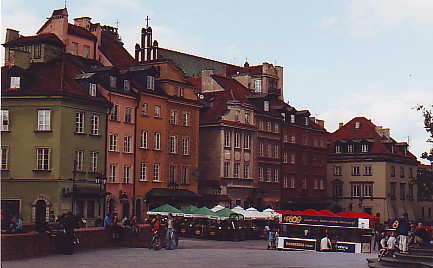
The old Town. House facades towards the Castle Square
The Old City of Warsaw is a residential area that has been rebuilt on the ruins after World War II. Original, ie not destroyed during the war, they are often gothic basements, certain house facades and fragments of portals. The reconstruction is based on preserved drawings and old pictures. The old town is located between Castle Square (Plac Zamkowy) and Barbakan. To the west, the district is surrounded by a defensive wall; the east side lies on the high river bank towards Wisła.
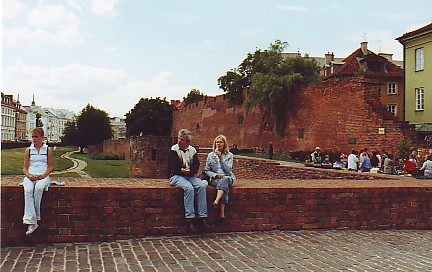
Ruins of the old city wall near Castle Square
The old town was founded in the early 14th century, but the current houses are copies of buildings from especially the 17th and 18th centuries, during which the old wooden buildings were replaced by stone houses.
Old Town Square .
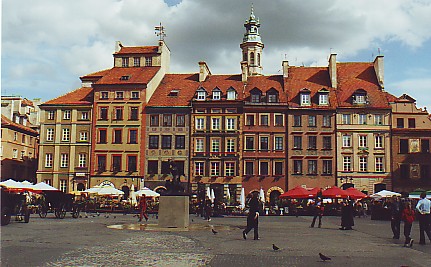
The southeast side of the square (towards Castle Square)
In the center of the district is a square square from the Middle Ages, from which narrow paved streets emerge.
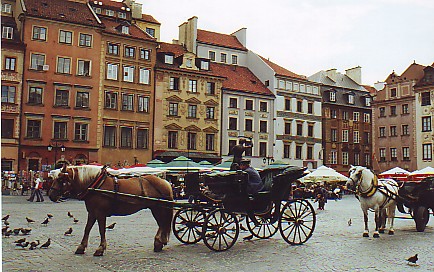
The southwest side of the square
In the middle of the square stands a sculpture: a mermaid, armed with swords and shields; this figure, the defending mermaid, is Warsaw’s symbol and is part of the city arms. (See also: Sculptures of the Warsaw Mermaid ).
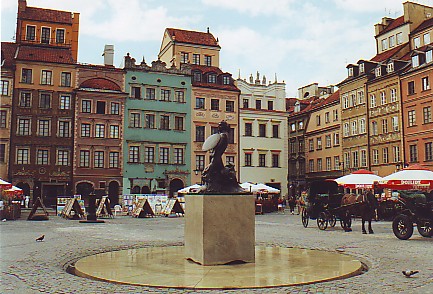
The northwest side of the square
In the buildings and basements around the square you will find restaurants, art galleries and museums. In the summer, tourists can relax in one of the many cafés and in the shade of the umbrellas enjoy a cup of coffee or a mug of beer.
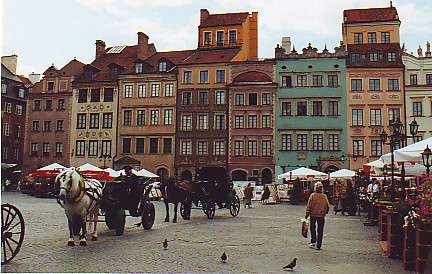
The northwest side of the square
The streets Świętojańska, Piwna, Zapiecek, Wąski Dunaj, Szeroki Dunaj, and Nowomiejska.
Świętojańska Street goes from the Palace Square to the Square. On the right, when coming from Castle Square, stands the Gothic St. John's Cathedral (Cathedral of St. John) , which was built at the transition between the 14th and 15th centuries. Here the last Polish kings were crowned. The building was destroyed by the Germans in 1944 and rebuilt after the war. In the basements below the cathedral there are tombs for eg. the Masovian princes.
Next to the cathedral stands Jesuit chapel , listed in the 17th century. Like the cathedral, the building was destroyed during the last war and later rebuilt.
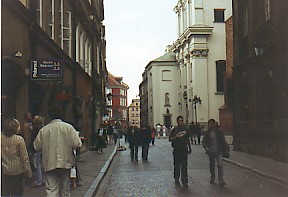
Ul. Świętojańska seen in the direction of the square
Piwna Street runs from Castle Square, parallel to Świętojańska. Here you should note St. Martin's Church from the middle of the 14th century. Close to this building stands The Nunnery of the Franciscan Order ; The monastery can be visited by going through the door at the end of the left side ship of the church. In this monastery formerly the land days of the nobility were held.
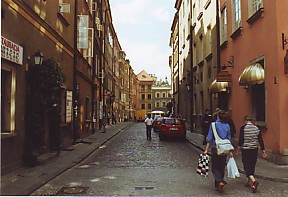
Ul. Piwna seen from ul. Zapiecek to the northwest
Zapiecek is a short street reminiscent of a square square; it lies just before the square and connects ul. Iwiętojańska with ul. Piwna. In a corner house is a blackboard commemorating the admirable re-creation of the Old City after the devastation of the war. In the street's paving there is also a blackboard from 1980 that is reminiscent of the Old City’s admission to UNESCO’s list of the world's cultural heritage.
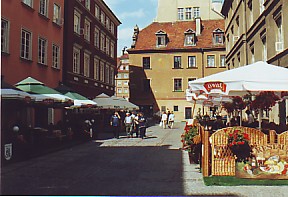
Zapiecek seen from ul. Piwna v Świętojańska
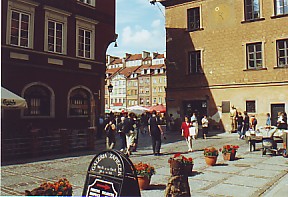
Zapiecek with Świętojańska and the entrance to the square
The extension of Piwna street is Szeroki Dunaj, where for centuries, markets for fish, vegetables and flowers have been held. At the end of the street stands a building, the so-called The executioner's house (Domek Kata) with a gate through which one can ascend the city wall.
You enter the street Wąski Dunaj either from Piwna or from the square. In a small building you find the modest*Museum of Leather Crafts* , where one can study the evolution of the shoe craft from the Middle Ages onwards.
You walk along Nowomiejska Street from the square via Barbakan to the New Town (Nowe Miasto).
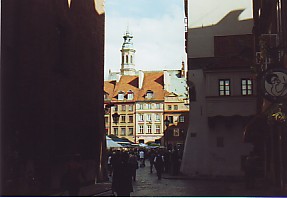
The Old Town Square as seen from ul. Nowomiejska
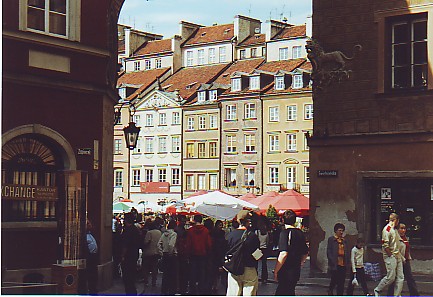
A charming look into the square from ul. Zapiecek
The city wall and Barbakan
The west side of the Old Town is surrounded by the city walls from the 14th-15th centuries.
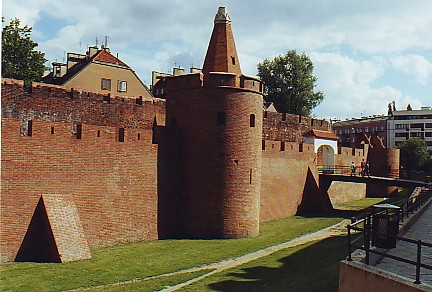
The northwest section of the outer city wall slightly south of Barbakan. In the middle of the picture is Baszta Prochowa (Powder Tower)
In connection with the walls are preserved Barbakan and Baszta Prochowa (Powder Tower). The Barbakan, erected in front of Nowomiejska town gate in 1548, is a fortification in the form of a tall, brick building with a rounded finish. The barbacan is equipped with a shooting cut and an inner yard.
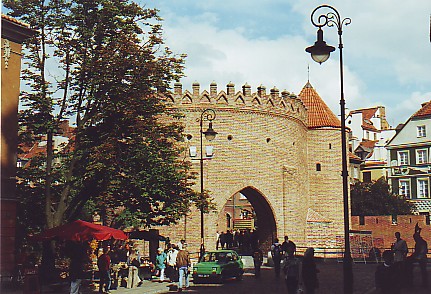
Barbakan seen from Nowe Miasto
Castle Square (Plac Zamkowy), Royal Palace (Zamek Królewski), Zygmunt Column (Kolumna Zygmunta):
The triangular Palace Square is the preferred meeting place of the Warsaw residents. To the east of the square stands the Royal Palace, to the west begins the Old Town and to the south the street Krakowskie Przedmieście forms the beginning of the so-called royal route to Wilanów. In the western part of the square stands the Zygmunt pillar.
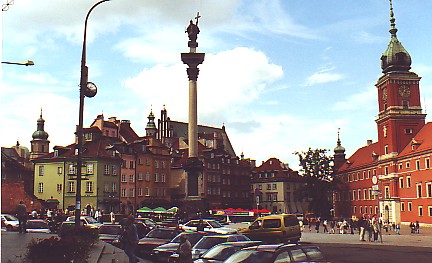
The castle square with the Royal Palace, the Zygmunt pillar and houses in the Old Town
In a tunnel beneath the square, a wide street (Trasa WZ) runs through the Śląsko-Dąbrowski bridge connecting Warsaw's center on the left bank with the Praga district on the right bank.
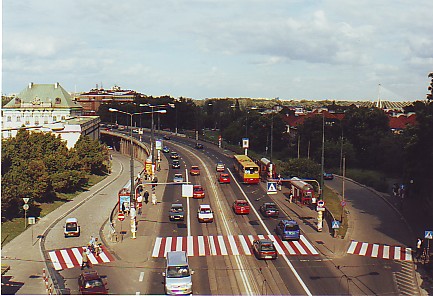
“Trasa WZ”, connecting the Center with Praga, seen from the Castle Square to the east. To the right are the houses in Mariensztat
The Royal Palace (Zamek Królewski, really: The Royal Castle)
The original castle, which was the seat of the princes of Mazowsze, was several times rebuilt and expanded by the Polish kings after the relocation of the capital from Kraków to Warsaw. The castle was the king's residence and framework for the Senate and Sejm meetings. In particular, the last king, Stanisław August Poniatowski, was active in decorating the castle; he remodeled the royal halls and classicist style furnishings. The works were led by Italian architects, painters and sculptors.
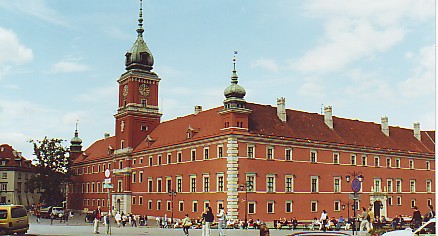
Royal Palace (Zamek Królewski)
After 1831, when the failed uprising against the Russian occupation took place, the most valuable collections in the castle were transferred to St. Petersburg. The castle now became the seat of the czar's statesmen in Poland.
After Poland regained its independence in 1918, the castle in the years 1922-1939 was the seat of the country's president.
During World War II, during the German siege of Warsaw, the castle was bombed and partially burnt down on 17 September 1939. However, during the fire and later after the Germans invaded Warsaw, they managed to save part of the valuable art collections and other decoration. After the defeat of the Warsaw Uprising in 1944, the Germans bombed the castle once again.
In 1971, the Polish government decided to rebuild the Royal Palace in Warsaw. In 1984, the building was commissioned and released for visits by tourists from home and abroad.
The Royal Palace is a three-story building erected on a pentagonal floor plan. At the bottom is the castle courtyard. In the center of the castle's main facade stands the square tower, the Clock Tower, through which there is an entrance to the castle courtyard.
Various events, concerts, permanent and temporary exhibitions are held at the castle. Visitors can access the castle's halls.
The first floor includes The Marble Hall, the Knights Hall, the Old Dungeon and the New Dungeon, the Conference Room, the King's Study Room, the King's Bedroom, the Senators' Exterior, the Little Chapel, the Banquet Room, the Chamber of Deputies, and the Senate Hall.
The rooms have been recreated on the basis of source material, in accordance with their function under King Stanisław August (1764-1795). The interior of the castle is adorned with works of art that were salvaged from the castle building before the final destruction during the war, including images by Bernardo Belotto, called Canaletto, Marcello Bacciarelli, Jan Bogumił Plersch, sculptures by Andrzej Le Brun and Jakub Monaldi, images by Philippe Caffieri and French furniture from the 2nd half of the 18th century. A significant portion of the decoration is gifts from state and government leaders as well as works purchased in recent times. – Link: Zamek Królewski .
Zygmunt column
On the Castle Square stands on a 22 meter high granite pedestal a statue in bronze by King Zygmunt III Waza. The statue itself is 2.75 meters high. Zygmunt III Waza, on the mother's side, was the grandson of the Polish king Zygmunt I of the Old of the Jagiełło dynasty and son of the Swedish king Johan III Vasa.
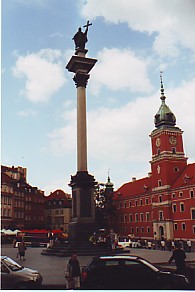
Zygmunt column
This is the first secular statue in Poland and it was erected in 1644 by Zygmunt’son of the Polish king Władysław IV. King Zygmunt III Waza, who appears with the crown on his head, wearing armor and coronation suit and with swords and crosses in his hands, glances in the direction of Krakowskie Przedmieście. The statue was destroyed in August 1944, but rebuilt in 1949.
Mariensztat:
Mariensztat is a residential neighborhood that was erected immediately after the war, in 1948. On small occasions, workers lived here, especially masons who rebuilt Warsaw. The houses, reminiscent of architecture from the 18th century, stand around a relatively large square. The small neighborhood at the foot of the slope facing the river and between the streets of Bednarska and Dobra is separated from the Old Town by the large street Trasa WZ.
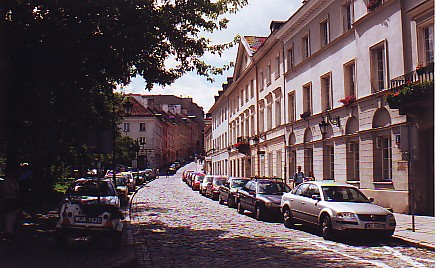
Ul. Bednarska in Mariensztat seen to the west – in the direction of Krakowskie Przedmieście
From the castle square you can see the Mariensztat as lying behind St. Anna's church. The neighborhood is a cozy area with paved streets, green spaces and cafe life. The name Mariensztat goes back to the 18th century, when Eustachy Potocki acquired the area, created a small private town here (which, however, has nothing in common with the current neighborhood) and named it after his wife Maria.
The New City (Nowe Miasto):
The New City begins at Barbakan and lies just like the Old Town towards Wisła. Nowe Miasto or Nowa Warsaw was organized between 1408 and 1791 as an independent city with its own government, its own town hall and its own church. 18.årh. replaced by brick mansions and 3-4 storey stone houses. Nowe Miasto was destroyed in August 1944, during the Warsaw Uprising, and rebuilt after the war.
The New Town Square (Rynek Nowego Miasta)
The square in the New Town is larger than the Old Town Square. The original square shape has been lost.
Sakramentkirken . In the square you can see the Baroque style Sacrament Church. Queen Maria Kazimiera built the church as a votive gift after her husband, Jan Sobieski’s, victory over the Turks at Vienna in 1683. The church was destroyed during bombing in 1944.
Streets: Freta, Mostowa, Kościelna.
Freta Street is the main street in Nowe Miasto. It goes from Barbakan to the square. Previously, free markets were held here.
On the left side of the street – seen from the Old City – stands the Holy Spirit Church from the beginning of the 18th century.
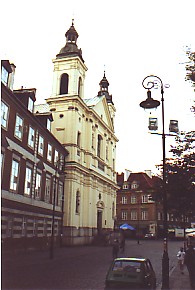
Ul. Freta in the New City with Holy Spirit Church (Kościól Świętego Ducha)
On the right side is the Church of Saint Jacek; this church was erected by contributions from the citizens in the first half of the 17th century. in this house was born the great science-woman who discovered the elements radium and polonium.
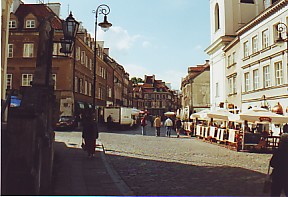
Freta Street
Ulica Mostowa (Brogade) goes right from Freta just after Barbakan. It is a picturesque street with the former bridge gate (Brama Mostowa, now called Stara Prochownia) from the 16th century, the only thing now reminiscent of the Zygmunt August Bridge in this place. From the lower part of the street there is a beautiful view of the city wall around the Old Town.
The small Kościelna street goes from Freta street down to the riverside Mariæ Vis Church. The street ends with a steep staircase leading down to the foot of the slope; From here there is a beautiful panoramic view of the Praga district on the other side of the river – with the dominant Saint Florian church in the background.
Warsaw – page 4
Warsaw – page 2
Translated into English by Google Translate. Spangshus.dk accept no liability for any errors or omissions in translation.
Map

Rating
Search
Most used tags
churches (205) Castles (86) Monasteries (79) Town walls (74) Lakes (71) Town halls (67) Rivers (65) Castles1 (62) Mansions (55) Museums (51) Regional museums (38) Town gates (36) Abbey churches (35) Castle ruins (30) Cathedrals (26) Forests (25) Health resorts (24) Mounds (23) Water sports (23) National parks (22)Click for all tags
Denne side er også tilgængelig på dansk. This page and contents is (c) Copyright 2018- www.spangshus.dk. Based on Inviator software by ISCA Software